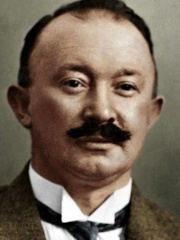
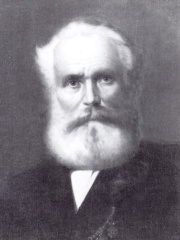
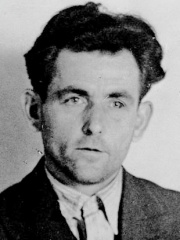

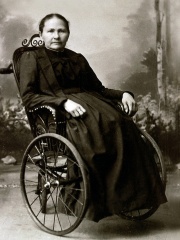



The Most Famous
DESIGNERS from Germany
Top 10
The following people are considered by Pantheon to be the top 10 most legendary German Designers of all time. This list of famous German Designers is sorted by HPI (Historical Popularity Index), a metric that aggregates information on a biography's online popularity. Visit the rankings page to view the entire list of German Designers.

1. Hugo Boss (1885 - 1948)
With an HPI of 73.83, Hugo Boss is the most famous German Designer. His biography has been translated into 33 different languages on wikipedia.
Hugo Ferdinand Boss (8 July 1885 – 9 August 1948) was a German businessman who founded the fashion house Hugo Boss. He was an active member of the Nazi Party from 1931, and remained so until Nazi Germany's capitulation. His clothing company also utilized forced labour drawn from German-occupied territories and prisoner-of-war camps to manufacture military uniforms for the Schutzstaffel and Wehrmacht.

2. Michael Thonet (1796 - 1871)
With an HPI of 70.03, Michael Thonet is the 2nd most famous German Designer. His biography has been translated into 21 different languages.
Michael Thonet (2 July 1796 – 3 March 1871) was a German-Austrian cabinet maker, known for the invention of bentwood furniture.

3. Georg Elser (1903 - 1945)
With an HPI of 68.33, Georg Elser is the 3rd most famous German Designer. His biography has been translated into 36 different languages.
Johann Georg Elser (German: [ˈɡeːɔʁk ˈɛlzɐ] ; 4 January 1903 – 9 April 1945) was a German carpenter who planned and carried out an elaborate assassination attempt on Adolf Hitler and other high-ranking Nazi leaders on 8 November 1939 at the Bürgerbräukeller in Munich (known as the Bürgerbräukeller Bombing). Elser constructed and placed a bomb near the platform from which Hitler was to deliver a speech. It did not kill Hitler, who left earlier than expected, but it did kill 8 people and injured 62 others. Elser was held as a prisoner for more than five years until he was executed at Dachau concentration camp less than a month before the surrender of Nazi Germany.

4. Dieter Rams (b. 1932)
With an HPI of 64.44, Dieter Rams is the 4th most famous German Designer. His biography has been translated into 29 different languages.
Dieter Rams (born 20 May 1932) is a German industrial designer who is most closely associated with the consumer products company Braun, the furniture company Vitsœ, and the functionalist school of industrial design. His unobtrusive approach and belief in "less, but better" (German: Weniger, aber besser) design has influenced the practice of design, as well as 20th century aesthetics and culture. He is quoted as stating that "Indifference towards people and the reality in which they live is actually the one and only cardinal sin in design."
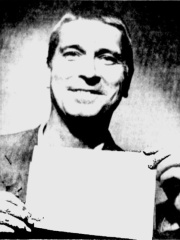
5. Hubert Blaine Wolfeschlegelsteinhausenbergerdorff Sr. (1914 - 1997)
With an HPI of 62.15, Hubert Blaine Wolfeschlegelsteinhausenbergerdorff Sr. is the 5th most famous German Designer. His biography has been translated into 20 different languages.
Hubert Blaine Wolfeschlegelsteinhausenbergerdorff Sr. (4 August 1914 – 24 October 1997; surname also given as Wolfstern, Wolfe + 666, Wolfe+585, Wolfe+590, and others) was a German-born American typesetter who held the record for the longest personal name ever used. Hubert's name is made up from 27 names. Each of his 26 given names starts with a different letter of the English alphabet in alphabetical order; these are followed by a long single-word last name. The exact length and spelling of his name has been a subject of considerable confusion due in part to its various renderings over the years, many of which have typographical errors. One of the longest and most reliable published versions, with a 666-letter surname, follows: Adolph Blaine Charles David Earl Frederick Gerald Hubert Irvin John Kenneth Lloyd Martin Nero Oliver Paul Quincy Randolph Sherman Thomas Uncas Victor William Xerxes Yancy Zeus Wolfeschlegelsteinhausenbergerdorffwelchevoralternwarengewissenhaftschaferswessenschafewarenwohlgepflegeundsorgfaltigkeitbeschutzenvorangreifendurchihrraubgierigfeindewelchevoralternzwolfhunderttausendjahresvorandieerscheinenvonderersteerdemenschderraumschiffgenachtmittungsteinundsiebeniridiumelektrischmotorsgebrauchlichtalsseinursprungvonkraftgestartseinlangefahrthinzwischensternartigraumaufdersuchennachbarschaftdersternwelchegehabtbewohnbarplanetenkreisedrehensichundwohinderneuerassevonverstandigmenschlichkeitkonntefortpflanzenundsicherfreuenanlebenslanglichfreudeundruhemitnichteinfurchtvorangreifenvorandererintelligentgeschopfsvonhinzwischensternartigraum Sr. While the Guinness World Records verified the version as follows: Adolph Blaine Charles David Earl Frederick Gerald Hubert Irvin John Kenneth Lloyd Martin Nero Oliver Paul Quincy Randolph Sherman Thomas Uncas Victor William Xerxes Yancy Zeus Wolfeschlegelsteinhausenbergerdorffwelchevoralternwarengewissenhaftschaferswessenschafewarenwohlgepflegeundsorgfaltigkeitbeschutzenvonangreifendurchihrraubgierigfeindewelchevoralternzwolftausendjahresvorandieerscheinenvanderersteerdemenschderraumschiffgebrauchlichtalsseinursprungvonkraftgestartseinlangefahrthinzwischensternartigraumaufdersuchenachdiesternwelchegehabtbewohnbarplanetenkreisedrehensichundwohinderneurassevonverstandigmenschlichkeitkonntefortpflanzenundsicherfreuenanlebenslanglichfreudeundruhemitnichteinfurchtvorangreifenvonandererintelligentgeschopfsvonhinzwischensternartigraum.

6. Margarete Steiff (1847 - 1909)
With an HPI of 61.65, Margarete Steiff is the 6th most famous German Designer. Her biography has been translated into 21 different languages.
Margarete Steiff (24 July 1847 – 9 May 1909) was a German seamstress who in 1880 founded Margarete Steiff GmbH, more widely known as Steiff, a maker of toy stuffed animals. Born in Giengen, Kingdom of Württemberg, Margarete contracted polio as a child, leaving her with both legs paralyzed and pain in her right arm. After training as a seamstress, she was able to raise enough money to purchase a sewing machine by teaching people to play the zither. She began making clothes, eventually opening her own store in 1877. Around this time, Margarete came across a sewing pattern for a toy elephant, as well as patterns for mice and rabbits. Using felt and lambswool, Margarete made many of these toys as gifts for friends, and later began to sell some. Proving popular, the scale of production steadily increased, as did the variety of toys. In 1902, the company began making a toy bear with moveable joints based on a design by her nephew, Richard Steiff. Taking off in the United States, it was nicknamed after then-U.S. president Theodore Roosevelt, becoming the first "teddy bear".

7. Luigi Colani (1928 - 2019)
With an HPI of 61.39, Luigi Colani is the 7th most famous German Designer. His biography has been translated into 20 different languages.
Luigi Colani (born Lutz Colani; 2 August 1928 – 16 September 2019) was a German industrial designer. His long career began in the 1950s when he designed cars for companies including Fiat, Alfa Romeo, Lancia, Volkswagen, and BMW. In 1957, he dropped his first name Lutz using the name Luigi. In the 1960s, he began designing furniture, and as of the 1970s, he expanded in numerous areas, ranging from household items such as ballpoint pens and television sets to uniforms and trucks and entire kitchens. A striking grand piano created by Colani, the Pegasus, is manufactured and sold by the Schimmel piano company. His unconventional designs made him famous, not only in design circles, but also to the general public. He received numerous design awards, although his unconventional approach left him largely an outsider from the mainstream of industrial design.

8. Otl Aicher (1922 - 1991)
With an HPI of 61.19, Otl Aicher is the 8th most famous German Designer. His biography has been translated into 22 different languages.
Otto "Otl" Aicher (German: [ˈɔtl̩ ˈʔaɪçɐ]; 13 May 1922 – 1 September 1991) was a German graphic designer and typographer. Aicher co-founded and taught at the influential Ulm School of Design. He is known for having led the design team of the 1972 Summer Olympics in Munich, and for overseeing the creation of its prominently used system of pictograms. Aicher also developed the Rotis typeface.

9. Anton Koberger (1440 - 1513)
With an HPI of 58.51, Anton Koberger is the 9th most famous German Designer. His biography has been translated into 15 different languages.
Anton Koberger (c. 1440/1445 – 3 October 1513) was the German goldsmith, printer and publisher who printed and published the Nuremberg Chronicle, a landmark of incunabula, and was a successful bookseller of works from other printers. In 1470 he established the first printing house in Nuremberg. Koberger was the godfather of Albrecht Dürer, whose family lived on the same street.

10. Erik Spiekermann (b. 1947)
With an HPI of 54.94, Erik Spiekermann is the 10th most famous German Designer. His biography has been translated into 15 different languages.
Erik Spiekermann (born 30 May 1947) is a German typographer, designer and writer. He is an honorary professor at the University of the Arts Bremen and ArtCenter College of Design.
People
Pantheon has 11 people classified as German designers born between 1440 and 1978. Of these 11, 3 (27.27%) of them are still alive today. The most famous living German designers include Dieter Rams, Erik Spiekermann, and Philipp Plein. The most famous deceased German designers include Hugo Boss, Michael Thonet, and Georg Elser.
Living German Designers
Go to all RankingsDieter Rams
1932 - Present
HPI: 64.44
Erik Spiekermann
1947 - Present
HPI: 54.94
Philipp Plein
1978 - Present
HPI: 52.95
Deceased German Designers
Go to all RankingsHugo Boss
1885 - 1948
HPI: 73.83
Michael Thonet
1796 - 1871
HPI: 70.03
Georg Elser
1903 - 1945
HPI: 68.33
Hubert Blaine Wolfeschlegelsteinhausenbergerdorff Sr.
1914 - 1997
HPI: 62.15
Margarete Steiff
1847 - 1909
HPI: 61.65
Luigi Colani
1928 - 2019
HPI: 61.39
Otl Aicher
1922 - 1991
HPI: 61.19
Anton Koberger
1440 - 1513
HPI: 58.51
Overlapping Lives
Which Designers were alive at the same time? This visualization shows the lifespans of the 7 most globally memorable Designers since 1700.


